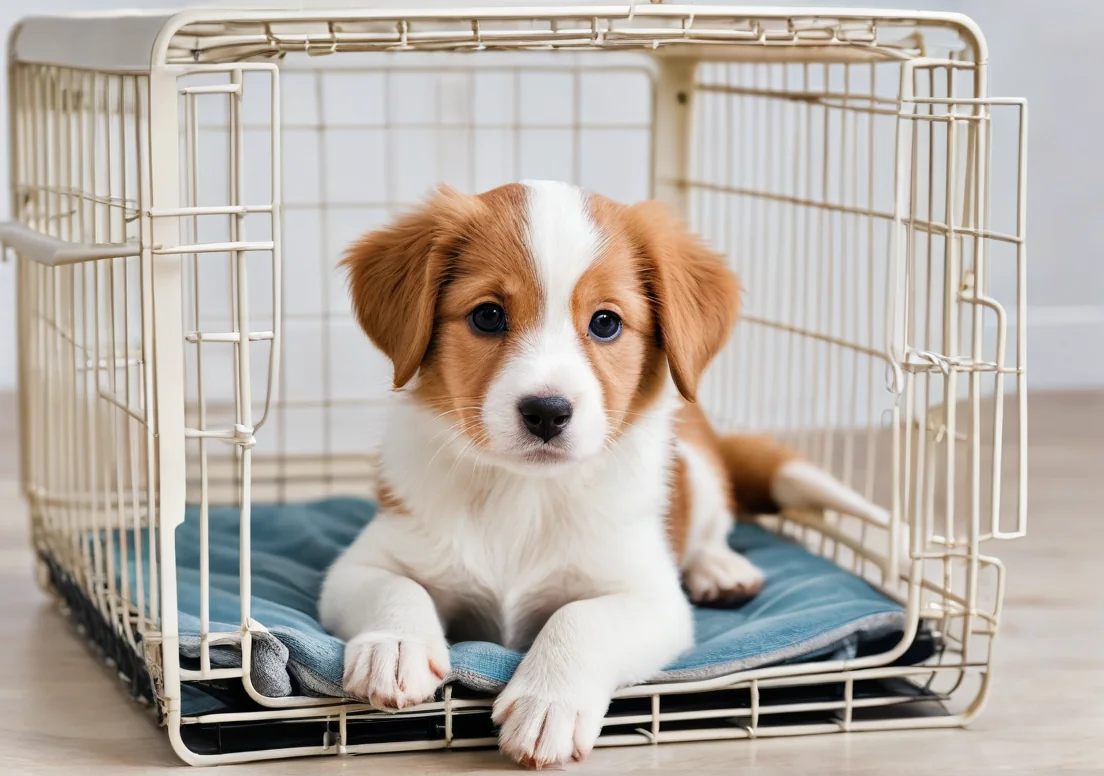Crate training your puppy can seem daunting, but it’s a vital skill that lays the groundwork for a well-behaved adult dog. The right strategies can transform the crate into a cozy den rather than a prison.
Focus on creating a positive experience through consistency, gentle introduction, and patience, while using the crate for training and safety. Exploring innovative tactics can enhance your approach and effectiveness; there’s a wealth of insights waiting for you below.

1. Choose the Right Crate
Selecting the right crate is crucial for your puppy’s comfort and security. It sets the tone for the entire crate training experience. Consider the size first—your puppy should be able to stand up, turn around, and lie down comfortably. If the crate’s too big, a puppy might use one corner as a bathroom, defeating the purpose of crate training.
Crate options vary, from plastic to wire to soft-sided. Plastic crates offer a sense of security and are great for travel. Wire crates provide airflow and better visibility, which can be calming. Soft-sided crates are lightweight and portable, perfect for specific circumstances, though they usually don’t offer the same security as the other types.
Tip: Look for a crate with a divider panel, allowing room for your pup to grow. As each puppy develops, their needs change, so having the right setup makes all the difference.
Additionally, always check for safety features like rounded edges and non-toxic materials to ensure a worry-free training environment for your furry friend.
2. Introduce the Crate Gradually
Getting your puppy accustomed to the crate shouldn’t be a rushed process; it’s all about creating a positive association. Start by placing the crate in a bustling area of your home so your puppy feels included. Leave the door open initially and let them explore it at their own pace.
Show Interest : Toss in a few toys or treats to pique your puppy’s curiosity. You want to create a homey vibe.
Encourage Exploration : Allow your puppy to sniff around the crate. When they step inside, shower them with praise.
Short Duration : When your puppy seems comfortable, encourage them to stay inside for short periods. Use a command like “crate” or “place,” but keep it casual and upbeat.
Increase Time : Gradually extend the time your puppy stays in the crate while you’re nearby. If they whine, avoid letting them out immediately—wait until they’re calm to reinforce good behavior.
Evening Routine : After a few successful days, begin using the crate during bedtime. Puppies generally need a den-like space for rest, so this can help them understand the crate is a safe zone.
Reminder: Each puppy is different, so be patient and give them time to adapt to their new space. Observe their reactions, and adjust the approach if needed to make it a comforting experience.
3. Use Positive Reinforcement
Rewarding your puppy for using the crate is a simple yet powerful way to build a positive association. When your pup steps into the crate on their own or goes in after your cue, give them a treat or some praise. This not only reinforces the behavior but also makes the crate feel like a special place—a cozy den rather than a punishment zone.
Consider creating a little ritual: toss a treat inside the crate and let them discover it. You can even add a favorite toy to make it more inviting. Each time your puppy explores and enjoys their crate, they learn that it’s a safe and rewarding space. Think of it like building a bridge of trust—every treat bridges the gap between their initial hesitation and a comfortable, familiar routine.
One unique angle is to use a clicker as a tool for positive reinforcement. When your puppy enters the crate, click and immediately reward them. This sound becomes a marker of their good behavior, helping them associate entering the crate with something truly rewarding. The key is consistency and timing—make sure to reward them right away for the best results.
4. Establish a Routine
A consistent schedule makes a world of difference when it comes to crate training. Puppies thrive on predictability, which helps reduce anxiety. By sticking to regular times for feeding, bathroom breaks, and crate time, your puppy will start to anticipate what comes next.
For instance, feed your pup at the same times each day, then take them outside for a bathroom break before crating them. This not only creates a routine but also helps them understand when it’s time to relax in their crate. A well-timed routine can lead to fewer accidents and promote a calm demeanor.
Incorporating a clear timeline for these activities could look something like this:
– 6:30 AM – Wake up and bathroom break
– 7:00 AM – Breakfast and playtime
– 8:00 AM – Crate time with a chew toy
– 12:00 PM – Midday bathroom break and socialization
– 5:00 PM – Dinner and more playtime
– 10:00 PM – Last bathroom break before bed
Having this sequence helps your puppy feel secure, knowing when they’ll have crate time versus active social time. It sets them up for success and fosters a sense of stability, making the crate a part of their daily life rather than a sporadic punishment. This predictability can significantly enhance their overall training experience.
5. Ensure Comfort and Security
Creating a comfortable and secure environment in your puppy’s crate is essential for successful crate training. Start by providing soft bedding that fits snugly in the crate, such as a washable dog bed or old blankets. This not only makes the space cozy but also helps with any anxiety your pup may feel.
Consider adding toys that are safe for your puppy to chew on. Chew toys or interactive toys can keep them entertained and provide a sense of security. It’s beneficial to include items that smell like you, such as an old t-shirt or scarf. A familiar scent can be incredibly reassuring for your puppy.
Make sure the crate isn’t too big. If it’s too spacious, they might use one corner as a bathroom and another for sleeping, which isn’t ideal. The crate should be just large enough for your puppy to stand, turn around, and lie down.
Lastly, ensure the crate is located in a low-traffic area of your home where they can still see and hear the family but won’t be overwhelmed with activity. With these adjustments, your puppy will start to view their crate as a safe haven rather than a punishment.
Fun Facts About Crate Training
Crate training offers more than just a place for your puppy to rest; it supports both their emotional and physical well-being. Recent research shows that well-crated puppies often experience less separation anxiety later in life. By introducing them to their crate positively, they learn that it’s a space for comfort rather than confinement.
Did you know that proper crate training can help with housebreaking? Puppies instinctively avoid soiling their sleeping area, making a crate an effective tool during potty training. Moreover, many trainers and veterinarians agree that crate training significantly increases a dog owner’s ability to transport their dog, as crated dogs typically exhibit less anxiety in cars and new places.
Another fun fact: crates can provide relief during flea and tick treatments. Keeping a puppy securely in their crate when applying treatments prevents them from running off and getting into trouble, and also makes the application process safer for both of you.
Understanding these benefits can change the way you view crate training—not just as a tool for housebreaking, but as a way to promote your puppy’s overall well-being and happiness.
Long-Term Benefits of Crate Training
Crate training isn’t just about keeping your puppy safe while you’re busy; it sets the stage for their future behavior and helps them become a well-adjusted member of your family. When done right, it can have several long-lasting positive effects.
First off, a properly crate-trained dog learns to view their crate as a sanctuary, a cozy place they can retreat to, reducing anxiety in new or stressful situations. Instead of feeling overwhelmed by loud noises or the chaos of a busy household, they can find comfort in their crate, which is especially important for any dog prone to anxiety.
Another bonus? It teaches potty training discipline. Dogs instinctively avoid soiling their sleeping areas, so a crate can help reinforce this natural behavior. In the long run, this can mean fewer accidents in the house, making your life a lot easier and keeping your home clean.
Crate training also encourages good behavior by providing a controlled environment. When you’re unable to supervise your puppy, a crate can prevent unwanted habits like destructiveness or chewing on furniture. By controlling their environment, you’re also guiding them toward better choices.
Here’s an interesting angle: regular crate time can aid in their socialization skills. Exposing them gradually to being in the crate while you’re home helps them understand they can be separate from you without stress. This can translate into improved independence and easier transitions for vet visits or when they must stay with a sitter.
And let’s not forget about safety—whether it’s during travel or day-to-day activities around the house. A crate ensures your puppy is secure, preventing accidents or injuries when you’re busy or distracted.
In the long run, crate training builds a strong foundation of trust and security between you and your pup. They’ll learn that their crate is a positive space, ultimately leading to a more balanced and well-behaved dog as they grow.
Alex, a passionate animal lover, has experience in training and understanding animal behavior. As a proud pet parent to two dogs and three cats, he founded AnimalReport.net to share insights from animal experts and expand his knowledge of the animal kingdom.




